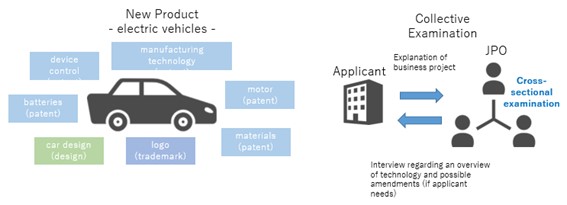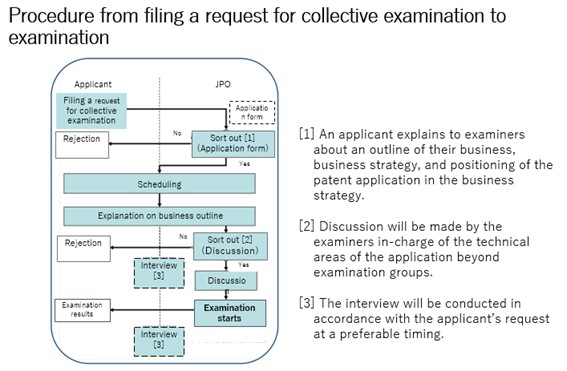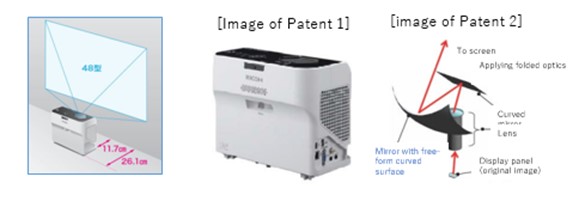Introduction
In April 2013, the Japan Patent Office (JPO) launched the Collective Examination system in response to the needs of supporting business strategies of applicants as globalization and diversification of their business activities accelerated. The Collective Examination system enables an applicant to obtain patents, trademarks, and designs at the best timing in accordance to their business strategy. The JPO examines those applications simultaneously, and grants the rights at the applicant's desirable timing. More importantly, it is only Japan that implements such a unique cross-sectional examination system in the world. This is part of the efforts of the JPO initiatives that the JPO aims at assisting applicants in developing their IP portfolios with a timely and transparent examinations. Now, the JPO carries out the Collective Examinations, while reviewing the current system and finding the most appropriate way for the applicants. This article introduces an overview of the current JPO's Collective Examination by distinguishing its features from regular examination. This article also gives readers insight of the system as well as useful tips to maximize a business strategy by considering case examples.
Overview of JPO's Collective Examination

A group of various applications (i.e., patent, design, and trademark) pertaining to part of a business project, a new product, and new service, are subject to Collective Examination. The JPO is able to adjust the timing of examination in order for an applicant to obtain IP rights at a suitable timing in line with their business strategy.
Even if multiple applications are filed and requested for examination at different timings and the applications come to be examined by different examination groups, Collective Examination offers the applicant to obtain a patent at the best timing in accordance to their business strategy. Prior to examination, an applicant is allowed to explain an overview of their business project related to their patent applications to examiners. Accordingly, the examiners shall first grasp a whole picture of the invention and technologies, and identify their position in the business before carrying out the examination.
Patent obtainment is possible at a necessary timing for your business project. JPO conducts cross-sectional examinations on patent, design, and/or trademark, which cover a wide range of your business pertaining to applications. Patent obtainment that leads to maximizing your business strategy is feasible. The examiners can conduct examinations with extensive understanding of the business and technologies. An applicant is allowed to undergo examination in a fair and uniform manner since examiners in certain technical fields consult with each other.

Case Examples of Collective Examination
The following case examples are excerpts and translated from the JPO published information.
[Ricoh]
Product: "Ricoh PJ WX4141," the world's smallest, lightest, and shortest throw projector
Technical feature: Patent 1 – vertical structure; Patent 2 – optic technology; Patent 3 – network technology
Subject of the examination: 14 patent applications related to ultra short throw projector
Examiners involved: 6 patent examiners in the fields of structure, optics, network, etc.
Filed/Granted: 13 of the 14 applications are granted
Time flow: approximately three months from filing to the first OA; approximately five to nine months from responding to the OA to the final OA

Comments from Ricoh:
- Comprehensive and earliest patent obtainment has become possible with the JPO's simultaneous and multiple examinations over a wide range of technologies pertaining to the product.
- On-time Examination was conducted in line with business planning.
- Examination results are made in an uniformed manner since the examiners collectively examine multiple applications.
[Canon]
Product: network cameras
Technical feature: Patent 1 – human presence detection; Patent 2 – auto-tracking system; Patent 3 – privacy masking
Subject of the examination: 14 patent applications related to network cameras
Examiners involved: 7 patent examiners in the fields of human presence detection, auto-tracking, privacy masking, etc.
Filed/Granted: All the 14 applications are granted
Time flow: approximately two months from filing to the first OA; approximately one to five months from responding to the OA to the final OA. Several patents were granted at the timing of the 1st OA.
Comments from Canon:
- Comprehensive and earliest patent obtainment has become possible with the JPO's simultaneous and multiple examinations over a wide range of technologies pertaining to the product.
- While JPO issued the OAs behind schedule so that the applicant could reduce the burden of prosecution work, JPO made all efforts for a swift examination process.
[Mazda]
Product: Automobiles with laminated coating film of exclusive paint color
Technical feature: Patent 1 – laminated coating film enabling ultimate red color "Soul Red Premium Metallic"; Patent 2 – laminated coating film enabling metallic black
"Machine Grey Premium Metallic"
Granted: 6 patents are granted.
Time flow: It took approximately eight months in total from filing to being granted.
Comments from Mazda:
- Throughout Collective Examination, Mazda was able to extend their passion for car design and the aim of car development which is the key to their business strategy.
- They realized at the interview that Collective Examination facilitates deep understanding of certain technologies at the JPO.
- Explanation on an outline of Mazda's business was effective to improve awareness of R&D staff on the importance of the IP.
Conclusion
As companies' business styles diversify their business activities, it is becoming more important for companies to garner intellectual properties and utilize them. Under these circumstances, the JPO provides the Collective Examination system which enables the following for companies (excerpts from the JPO website):
1) Collectively carrying out examination of a group of various applications that are part of a business project, covering any fields of patent, design, and trademark;
2) Timely examination that supports the acquisition of rights in line with business development; and
3) Quality examination based on an understanding of the background of the applicant's business project and of the technical relevance among a group of various applications.
The Collective Examination system targets a group of multiple applications related to technologies that constitute products/services necessary for a new businesses project or a global expansion plan. The timing of granting rights for a group of multiple applications is tailored to the applicant's needs even if there are differences, for example, in the dates of filing applications, the dates of requesting examination, or the examination departments/offices in charge.
Thus, all you need for utilizing the Collective Examination is to clearly describe the concept of your business project and the technical relevance, and effectively present the same to JPO Examiners. Why don't you utilize the Collective Examination system to maximize your business strategy!?
[Reference site: "Collective Examinations for IP Portfolio Supporting Business Strategy (CEIP)" https://www.jpo.go.jp/e/system/patent/shinsa/matome_sinsa.html ]
The content of this article is intended to provide a general guide to the subject matter. Specialist advice should be sought about your specific circumstances.
